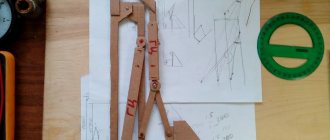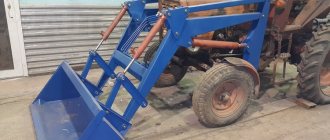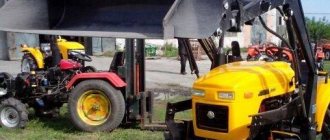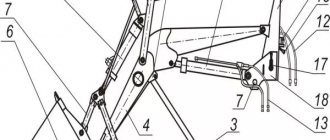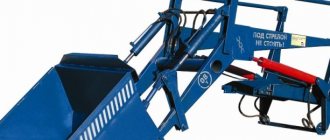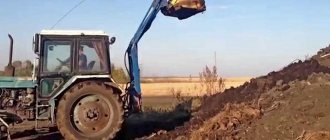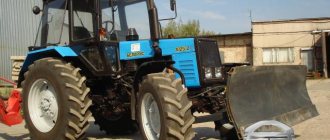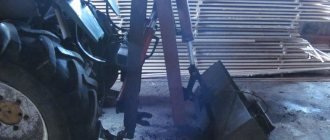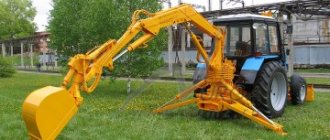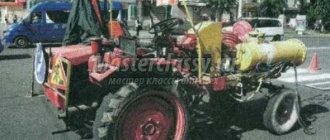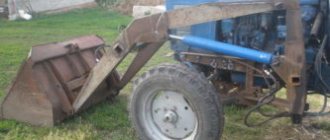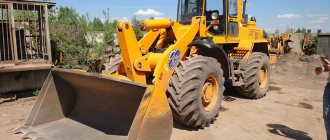- home
- Media center
- Articles
- Loader for the rear linkage of the MTZ tractor
Menu
- News
- Articles
- Video materials
- Photo materials
- Publication in the media
- 3D tour
24.11.2020
Powerful and reliable tractors MTZ 80 and MTZ 82, models of the Minsk plant of the last Soviet five-year plans and their modern modifications continue to be used in agriculture to this day. The multifunctional tractor is equipped with front and rear linkages, which include hydraulic systems and power take-off mechanisms.
The industry offers serial versions of attachments, but farm mechanics use homemade manipulators, gaining savings in terms of maintainability and maintenance without specialized workshops.
The rear loader can be equipped with:
- KUN devices, allowing the use of replaceable mechanisms, haylage rake modules, haystacks;
- manipulator forks capable of moving large and voluminous loads (hay, silage);
- devices with jaw grips for wood or land management work;
- a bucket for collecting soil, crushed stone, and loose fractions;
- telescopic retractable boom, load lifting hook.
Device for row-spacing processing
The most common household equipment is the row ripper.
The relevance of using such a product is due to the need to process narrow areas. This, in turn, requires such a cultivator to be compact, simple and easy to use.
The “Hedgehog” model copes well with the cultivation of such plots.
To make such a device yourself, you must adhere to the following sequence of actions:
- Buy a cutting.
- Mount the bracket in the shape of the letter U with holes at the ends.
- Prepare the wheels and shaft.
In this case, the rotating elements can be made with your own hands. Old steel pancakes of small dimensions with welded metal pins are perfect for such products. The last parts can be made from reinforcement with a cross section of 8-10 mm. When installing such spikes, it is necessary to give them a cone shape.
Prepared cutting elements - cutters are mounted on the axis. In this case, the fixation of such a structure is carried out by means of a bolted connection through prepared eyes.
At the moment, the use of special miniature devices is a fairly common activity in suburban areas.
We invite you to watch a video about a homemade cultivator on the MTZ 80 designed for hilling:
Fastening and lifting mechanism
Tractor trailer unit 2PTS-4 for mounting the blade
A do-it-yourself blade must have a strong, reliable lifting mechanism and strong fastenings. To do this, it is necessary to make a strong welded structure that looks like the letter “A”, which has additional steel elements located longitudinally and to which a special bracket must be attached by welding in the area of the middle jumper. It is advisable to use a ready-made hydraulic cylinder as a lifting device for the blade; it is best to buy the corresponding unit from a 2PTS-4 tractor trailer.
Universal mounted bucket
A homemade KUHN for a mini tractor is one of the types of front loaders. It is indispensable when you need to transport or load large volumes of bulk (and other) materials, such as sand, crushed stone or grain.
The mini tractor itself differs in size from a full-fledged tractor. Using a bucket allows you to turn a simple tractor into a universal vehicle for a wide variety of types of work.
Front loaders have a number of advantages:
- easy maintenance;
- reliability;
- ease of installation and dismantling of equipment;
- serious load capacity for a small-sized tractor;
- ease of control due to enhanced hydraulics.
Making a ladle
You can buy a bucket for a mini tractor at any hardware store, but this is not the cheapest pleasure, so it’s easier to make it yourself. You don't need any special knowledge or materials here. To work, you need to stock up on drawings, a grinder, a welding machine and the material itself.
Advice! A metal sheet with a thickness of 6 mm or more and pipes of various diameters are best suited for these purposes.
- First you need to make the fasteners. It is welded to the box and engine, and a metal corner is welded underneath for reinforcement.
- The KUN itself is made from pieces of sheet metal. There is no point in bending the sheet to fit the shape of the ladle. It is much easier to cut rectangles of the required size and weld them together to form a ladle. The durability of the product depends on the quality of the seams. It is better to use pipes with a diameter of 100 mm for racks, and 50 mm for rods.
- The next stage is the installation of the hydraulic booster. For greater mobility, it is recommended to use a pipe with a diameter of 30 mm (it should not be more than 50 mm, otherwise the pipes will not move well inside each other).
- Now the support is welded to the front of the tractor and combined with the racks; gussets are used for reinforcement.
- A cylinder is used to control the rotation of the bucket. It is usually installed to the right of the bucket.
Safety precautions when working with a bucket
Making a bucket for a mini tractor is not very difficult, the main thing is to have knowledge and experience in working with welding, and be able to work with drawings. In order for the attachments to work correctly, you need to approach the work responsibly and do everything strictly according to plan, otherwise the result may not meet expectations, and the mini tractor itself with KUN will pose a danger to the operator.
Advice! If you have doubts about the success of the event, you should refrain from making the KUN yourself and purchase it in the store.
To ensure safety during operation, you should follow the operating rules:
- KUN can be used only for its intended purpose;
- When working, you should carefully monitor the bucket;
- When driving with a loaded bucket, you need to keep it lowered, that is, near the ground.
Pros of installing hydraulics
- The car becomes easy to control. The steering wheel can be turned with virtually no effort, with one hand.
- Hydraulics makes it possible to use various attachments.
- The use of hydraulics allows you to modernize the brake system. Thanks to the hydraulic cylinders installed on the unit, the unit brakes instantly.
You can make hydraulics on a mini tractor if you purchase a ready-made system in advance in a store or use parts from old agricultural machinery.
The main advantage of Coons is their versatility. Other advantages of this type of attachment include:
- installation and dismantling of kuns on a mini-tractor of any model;
- simplicity and ease of maintenance (all components are accessible and easy to change in case of wear or breakdown);
- ease of control due to the hydraulic system of the agricultural machine;
- reliability in operation;
- high load capacity.
This is especially important for farmers and owners of gardening farms, where there are no more powerful tractors and tractors (for transporting bulky cargo, large volumes of grain, bulk building materials). The clutch unit is attached to the gearbox, also taken from a car. You can see how the clutch is installed in this video
You can see how the clutch is installed in this video
The clutch unit is attached to the gearbox, also taken from a car. You can see how the clutch is installed in this video.
The following is a diagram that shows how the standard steering control installed on most self-propelled vehicles works.
Homemade KUN for MTZ
The cost of the equipment, including compact models with lower productivity, is high, however, the KUN for the rear linkage of the MTZ or Uralets tractor can be made independently from available materials. Tractors of this brand are equipped with a hydraulic system that allows the KUN to be mounted on the MTZ rear suspension - this is convenient, and the installation of such a loader is simpler than its front-end counterpart. The advantage is the ability to select the optimal boom length and material unloading height.
In the process, you will need a welding machine, a tool for cutting metal, a hammer, a sledgehammer and a set of adjustable wrenches. Experience with a welding machine is desirable - the quality and reliability of welding, which affects the performance characteristics of the future loader, may depend on this.
Structural elements:
- profiles and sheet metal, the thickness of which corresponds to the planned load on the unit;
- hydraulic cylinders - one larger to create a lifting mechanism and two smaller ones to adjust the bucket tilt parameters;
- cylindrical hinges for assembling the structure.
Homemade KUN at MTZ
Drawings of KUN loaders for MTZ 80 and 82 of various capacities are presented on the Internet - we recommend that you carefully read them in order to cut metal with minimal waste.
The frame of the future loader consists of 2 rectangular frames. External and, accordingly, larger in size, it is aggregated to the rear canopy of the tractor. The internal one consists of sheet metal. A large hydraulic cylinder is fixed in its lower part, and a spacer is welded to the upper part, which acts as a stiffener.
The boom structure is prefabricated. The main part of the structure makes up 70% of the length of the product, is placed as close as possible to the frame and is aggregated with the cylinder. The middle part of the structure is attached to this fragment of the product using hinges, and the bucket is attached to it. An important parameter is the boom radius - if it is more than 2 m, the front semi-frame must be equipped with a counterweight.
Important: Should you buy the Enifield Titan MK1000 walk-behind tractor: owner reviews, technical specifications, price
The bucket can be purchased or made from sheet metal. the final design looks like a boomerang with three attachment points - central and one at each end. Installation of KUN on a tractor can be done independently. Before testing the device, be sure to check the reliability of the connections and fastenings.
This is interesting: Review of the universal and multifunctional mini tractor Kyoti CK35 - let’s break it down point by point
Necessary materials
You will need a small amount of tools and materials for a homemade loader on the MTZ rear linkage, but the main factor is the ability to handle all the necessary tools.
Tools:
- The main tool will be a welding machine. It is very important to be able to use it, since the strength, reliability and durability of the entire structure, as well as the safety of the tractor driver, will depend on this.
- You need a precision tool to cut metal. In this case, a grinder, a gas cutter, and the like are suitable. The main thing is that the cut is accurate and even.
- Next, you just need a variety of tools that are usually available on all farms: these are adjustable wrenches, a sledgehammer, hammers, and the like.
Details:
- It is necessary to purchase or remove 3 hydraulic cylinders from unused equipment: one large one, which will raise the boom with the bucket, and two small ones to change the angle of inclination of the bucket itself. The power of the cylinders is selected depending on the length of the boom and what weight needs to be worked with.
- It is necessary to obtain metal profiles and plates, of which the further structure will consist. Their thickness is also selected to suit the tasks assigned to the loader.
- Cylindrical hinge joints are needed, but their selection should be done only after drawing up a drawing of the entire structure. This is necessary not only in order to obtain the required quantity, but also to know the load that they must cope with in the future.
- First, you need to prepare a drawing of the entire structure, and only then cutting the metal, welding and assembly. This is necessary not only in order to use the material as efficiently and economically as possible, but also to better understand the future design and achieve maximum strength. About the design below.
Step-by-step instruction
If you follow the instructions, you won’t have any problems creating your own loader for the MTZ attachment:
- First you need to make the frame of the base of a homemade loader for a tractor. It is a rectangle, the lower part of which extends beyond the edges, since it must be installed on the rear canopy of the tractor. In the center of this frame there is also a rectangular frame, which is made of two plates and welded to the upper and lower edges. A large hydraulic cylinder will be attached to this frame at the bottom, and at the top there will be a strut that is attached to the back and holds the entire frame in place. There should be four hinge joints on the top face: two in the center for the upper cylinders and two outer ones for the boom. The height of the base is determined according to needs.
Drawing of the lifting frame of a homemade loader
1 – stand; 2 – boom lift hydraulic cylinder; 3 – support; 4 – lifting frame; 5 – hydraulic cylinder for tipping the bucket; 6 – ladle; 7, 11 – traction; 8, 10 – bracket; 9 – pointer; 12 and 13 – high pressure hoses; 14 – bracket; 15, 17 – lever; 16 – clamp; 18 – sidewall. The boom is a prefabricated structure. From the side attached to the base, this is the main and longest part, which represents approximately 70% of the total length. An extension is attached to it at an angle of 30 degrees, which should look up. Thus, a shape similar to a boomerang is obtained. You should get two curved profiles, which are connected to each other in three places - at the ends and in the center. Also closer to the central part, but from the side of the base (approximately 25% of the total length), a frame is welded to which the second end of the main cylinder is attached. The central part of the boom is made in the form of a hinged cylindrical joint, since the bucket control lever is attached to it. It consists of two elbows (40 degree bend), to which two small cylinders are attached on one side, and on the other side a crossbar for further connection directly to the bucket. All the described parts are connected on hinges, and the two elbows have one common
It is very important to make the central part immediately assembled with the hinge joint, since it will not be possible to put it on later.
Drawing of a rack for fixing attachments 1 – sidewall; 2, 3, 4 – bracket; 5 – catcher; 6, 10 – lever; 7 – clamp; 8 – rod; 9 – spring; 11 – latch; 12 – axis. Now it's just a matter of the bucket. You can either purchase it or make it yourself according to ready-made drawings. You can also use a forklift for pallets or bales instead of a bucket. If the boom has a reach of more than two meters, it may be necessary to additionally weight the front part. To do this, you will need to weld a basket for sand, concrete blocks or metal weights onto the frame.
The video shows a homemade loader on a tractor in action:
Difference in attachments
If the PKU - 0.8 is attached directly to the tractor frame, naturally disrupting the uniformity of the load during operation and putting pressure on the frame with the entire loaded mass, which leads to premature breakdowns when working with heavy loads, then the PF - 1 is equipped with its own frame, attached under the tractor to the rear axle , which evenly distributes the entire load.
In addition, PF-1 uses slightly more powerful cylinders, while the boom and other parts with mechanisms are made from reinforced (thickened) metal. Consequently, despite all the external similarities, the KUN on MTZ of different models still has significant differences in operation.
Note
Many skilled mechanics make the KUNS they need with their own hands, producing quite working and acceptable attachments. This does not mean that it is necessary and possible to refuse to purchase a high-quality factory product, but it does not exclude this possibility.
However, any homemade KUHN, even one manufactured according to all the rules and regulations, is certainly technically inferior to its factory-made counterparts.
KUHN for the rear linkage of a tractor: what equipment can be used
The homemade product installed on a mini tractor with KUN can be of two types:
- Equipment type PF-1, which has its own supporting frame. This homemade KUN is attached to a tractor, which protects the machine from overturning. Such equipment weighs about 900 kg, is driven by hydraulic cylinders, has a load capacity of 1 ton and a speed of 20 km/h.
- The PKU-08, which is a more modern modification of the PF-1, is also installed on the rear linkage of the MTZ 82. It is not difficult to attach a homemade KUHN or a KUHN assembled in a factory to a tractor. But it is worth considering that PKU-08 is distinguished by its ability to carry less cargo than the previous equipment model. The PKU-08 weighs only 700 kg, reaches a speed of up to 20 km/h, and is capable of lifting 800 kg of cargo at a time.
The kuna model on MTZ 80 or MTZ 82 is produced at the Salskselmash plant, which specializes in agricultural machinery. KUN 10 is a functional and practical boom, created specifically for the specified MTZ models. But it can also be installed on a Chinese tractor. Although it is with Minsk technology that the equipment works best. Among the advantages of KUN 10 it is worth noting such characteristics as:
- Versatility. The Belarus tractor is capable of being a loader and performing earth-moving work like an excavator. The machine is also used as a bulldozer or leveler.
- Compactness. The installation of KUN 10 at MTZ allows the equipment to be used in the city and on small construction sites. Therefore, such a tractor is constantly used for landscaping territories, digging holes and trenches, laying communications, etc.
- High level of productivity.
- Reliability.
- Ease of use.
- Easy to use.
Important TOP 5 series of American agricultural combines New Holland
KUN for wheeled tractors has the following design:
- The boom, which is controlled by four hydraulic mechanisms, two of them are used to lift loads, and another two are used to adjust the angle of inclination of the bucket.
- The drive that powers the chassis. Its system also has the option of a connector, with the help of which it is connected to the tractor.
- The boom control panel is installed in the tractor cab.
- Buckets can have different volumes, which vary from 0.35 to 1.5 m³.
How to choose
When choosing equipment that is necessary for loading operations, it makes sense to compare the characteristics of construction machines of the same type: DT-75 and MTZ.
For DT-75
This machine can have several sets of attachments: for agricultural work, for general construction work, and drilling. A front-end loader on the DT-75 can be installed thanks to the installation of side-mounted semi-mounted equipment.
The updated modification of the DT, the engine for which is now produced in the city of Vladimir, has a new, more ergonomic cabin.
Loader specifications vary by model. PG 2 has a bucket with a capacity of 1.5 m³, the unloading height reaches 2.7 m with an angle of 50°. The width of the bucket edge (grip) is 2028 mm.
The PFP 1.2 front-end loader has a narrower specialization. It is designed for loading bulk materials and fertilizers. Its parameters:
- bucket capacity 0.9 m³;
- unloading height 2.5 m;
- working width 2035 mm.
In addition, combined and homemade loaders are used.
For MTZ
A loader based on the MTZ produced by the Minsk Tractor Plant is obtained by installing mounted units on the tractor. Its basis is a wide bucket with a grab for bulk materials. In the standard version (for example, the MTZ-1221 front loader) consists of:
- a controlled frame with a hydraulic system is the main part of the structure;
- chassis;
- nozzles
The MTZ-82, which has a kun as additional equipment, has also proven itself well. This is a swept unit controlled by four hydraulic drives. Two of them work in the horizontal plane, and two more regulate the movement of the bucket.
Model overview
There are different models of grab loaders available. Let's look at the most popular grab loaders that are most often used.
Karpatets PEA 1A
Karpatets PEA 1A is designed for loading, excavating and leveling work. It is used when greater lifting capacity, speed and boom reach are needed. The mechanism performs work without moving due to the large angle of rotation of the boom.
- Loading capacity - 1 t.
- The grab volume is 0.67 m³.
- Productivity - 240 t/h.
- Turning radius - 270º.
- The loading height with a grab is 4.3 m.
- The maximum digging depth with an excavator shovel is 2.5 m.
- The volume of the excavator shovel is 0.44 m³.
- The width of the excavator shovel is 0.7 m.
- The width of the bulldozer blade is 2.45 m.
- The height of the bulldozer blade is 0.73 m.
- Ground clearance - 0.4 m.
- Travel speed is 25 km/h.
- Dimensions - 6.75x2.20x2.67 m.
- Weight - 7575 kg.
Instructions for making KUN
Before work, you should carefully read the instructions on how to make a KUN on a mini tractor with your own hands, and watch the videos. Then you need to prepare the drawings. You can download them ready-made, or you can do them yourself, adjusting them strictly to the size and modification of the tractor.
The pattern of the parts is transferred to cardboard (corrugated cardboard from old boxes is suitable) in full size and cut out. Steel parts are marked and cut out using them. It is most convenient to mark with a marker - it does not erase, and after painting the marks will not be visible.
Necessary materials
For production you will need:
- For arrows: channel 10, sheet steel 4 mm.
- For racks: channel 18, sheet steel 10 mm.
- Fingers with blanks under them.
- Hydraulic cylinders grade 80-40-400 and 80-40-630.
- Loading lugs.
- Primer and paint for metal.
- Cardboard for cutting out templates.
- Tools you will need:
- Welding machine.
- Bulgarian.
- Metal scissors.
- Marker for marking.
The KUN for the rear linkage of the T 40 tractor is made of channel and steel. Factory structures are welded from the same material. The channel is used to manufacture the basic structure, onto which the actual working equipment is then hung: boom, loader forks, bucket.
Working equipment can also be made independently from channel and sheet steel, but, of course, it is better to do without it - perhaps you can find a bucket from an old excavator in the garage or you can buy a used boom. The fact is that without a sheet bending machine it is quite difficult to bend sheet steel exactly to size, and manufacturing using a vice and scissors will take so much time that the question of the payback of such a “homemade product” may arise. Hydraulic cylinders and lugs can be removed from an old truck or purchased at a wrecking yard.
As a rule, any craftsman has a certain supply of channel bars, but even if you need to buy all the materials at the base, it will be almost half the price than buying ready-made equipment. You can also consider purchasing metal from your own hands. If it was stored correctly, it will not be inferior in quality to a new one, and will cost significantly less.
Procedure
Manufacturing steps:
- Weld the right and left half frames.
- Secure the working equipment to the front (right) half-frame.
- Weld the left half-frame to the left side member, and the right half-frame to the right.
- Connect the half-frames with crossbars. The result is a supporting frame.
- Install hydraulic cylinders on the frame and connect them to the tractor hydraulic system.
- Before installation, the structure must be primed and painted to protect it from corrosion.
- A properly manufactured KUN is capable of lifting up to 800 kg with a loader and up to 600 kg with a bucket or mounting hook.
It is very important not to try to increase the weight of the hitch in an attempt to achieve more power. You need to focus on the capabilities of the tractor, and the 0.9 class, although it has wide capabilities, still refers to light semi-professional machines
Constant overload will lead to wear and tear of the chassis, engine, and transmission.
Homemade loader for a mini tractor with your own hands. Do-it-yourself loader on a mini tractor
When purchasing any agricultural equipment, every owner quite reasonably strives to use it to perform a wide range of tasks. Mini tractors have become extremely popular today, allowing them to perform a wide variety of work, from land excavation to construction. However, it is not always possible to buy such a mini tractor complete with a loader, the cost of which separately is quite high. In this case, making this part yourself can be a real salvation, since it will allow you to use the vehicle to move various bulk building materials.
Where to begin?
To make your own loader for a homemade mini tractor, you should take into account the model of the vehicle itself, since the weight of the attached unit will depend on this. In addition, it is necessary to find a diagram reflecting the mechanism for lifting the bucket to a certain height and controlling it from the tractor cabin
Important Types and features of skidders
Considering the sufficient complexity of such a mechanism, this task should be approached very responsibly, having carefully thought out the design on paper.
In order not to reinvent the wheel, it is best to take as a basis the lifting mechanism that is used on many models of domestic tractors. The design itself consists of 3 main parts:
- The actual bucket.
- Hydraulic lift mechanism.
- Systems for attaching a loader to a minitractor and bringing control elements inside the cabin.
Step-by-step production of all structural elements
First you need to make a loading bucket (1), which can be made from several steel plates, at least 6 mm thick, welded at the desired angle. According to the given dimensions, it is necessary to weld the side elements, and along the lower longitudinal part - ridges that will well grip bulk building materials of various fractions. Then we proceed to the implementation of the most complex mechanism - the hydraulic lifting system, for which we will need the following elements:
- 4 levers (2) – here it is best to use a square pipe of a suitable cross-section, in which it is necessary to make holes for connecting bushings;
- boom (4) – is made of a U-shaped channel and is attached on one side to the bottom of the bucket, and on the other to the frame of the mini tractor;
- hydraulic lifts (5.6) - they are best purchased ready-made, which can be found on the market for transport parts for tractors.
In addition, this mechanism will also need bushings, pins, brackets, adapters and connecting fingers, which should be sequentially assembled and fastened together
It is very important that a homemade front loader for a mini tractor has the correct center of gravity, which will avoid accidental tipping due to overweight. The sketch under number 3 indicates the location of the vehicle wheel, which will allow you to correctly navigate the loading mechanism location system relative to the tractor itself
Key Findings
When performing the entire complex of work, it is very important to maintain the required proportions, since the slightest inaccuracy can lead to the mechanism not working. To do this, from the very beginning you should carefully approach the project, accurately calculating the dimensions of all parts
The elements used should be made of durable materials, which should preferably be treated with anti-corrosion compounds. Thus, making a loader for a mini tractor with your own hands is quite possible, which only requires attentiveness and skills in working with metalworking and welding tools.
Motoblock. Start
The walk-behind tractor is the fruit of the late Soviet period, or rather, the era of the legendary six hundred square meters. In the mid-eighties, the Soviet government was forced to admit that the system of collective and state farms, despite being fully equipped with a fleet of modern equipment, including giant combine harvesters and agricultural aircraft, and the help of the country’s population (who doesn’t remember the “potato growing” trips?), fulfilled its main purpose function is not able to. The country was forced to purchase food from abroad.
It was decided to act on the principle “saving drowning people is the work of the drowning people themselves,” and supplying workers with agricultural products was partially entrusted to the workers themselves. Those who wished were given a plot of land with an area of six hundredths of a hectare (those same six hundred square meters).
To process even such a modest plot with the help of a shovel, a hoe, and the mother of an unknown Japanese at the end of the second millennium in the country of victorious socialism, which proclaimed the Scientific and Technical Revolution, was completely out of hand. And then it turned out that there was practically no equipment in the country capable of solving such problems. Personal plots of collective farmers, as a rule, were part of one field and were processed with one or two passes of “adult” equipment. This method was absolutely not suitable for patchwork “six-hundred” plots.
A fundamentally new type of agricultural machinery was developed, called a “motorized block” or walk-behind tractor. The “Unknown Little Animal” was a heavy motorcycle engine mounted on two coaxial off-road wheels. Working with such a unit was reminiscent of peasant labor at the beginning of the century - the plowman walked behind the horse, guiding the plow and putting pressure on it with his own weight.
Only the place of the horse was taken by a two-wheeled miracle of technology, controlled and directed using special handles. Instead of a plow, a set of attachments was used, thanks to which the walk-behind tractor could plow, harrow, sow, and mow grass. There was even a two-wheeled body with a seat, which turned the walk-behind tractor into a vehicle of unknown purpose: for movement and movement of goods around the village and the surrounding area, a motorcycle with a sidecar (another, almost forgotten relic of the past) or a car was clearly more convenient. And there was clearly no place on the highway for an incomprehensible hybrid moving at the speed of a lame mare.
Important Telescopic cargo and cargo-passenger construction mast lifts
Valentin Kozhedub | Topic author: Rebeca
testing a loader as a crane.
V (Caris) why suddenly? ! the hitch is designed for lifting loads! from the front frontal you can break it faster. and in this version, if you start to take a heavy load, then the tractor just rears up and that’s it.
Maxim (Rebeca) and my papalam was breaking the gap
Read also: Perennial Rudbeckia from seeds
V (Caris) is it really from the rear load? This means the gap was cracked, and the loader finished it off.
Maxim (Rebeca) didn’t stick a knife in the front, but pushed the loaded cart and broke it. Who did I buy this tractor from? I tore out the central screw with a piece of the hydraulic tank; he had a bucket hanging on it
V (Caris) I sympathize... anything can happen...
